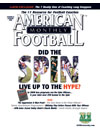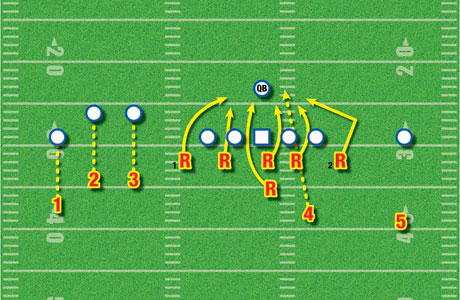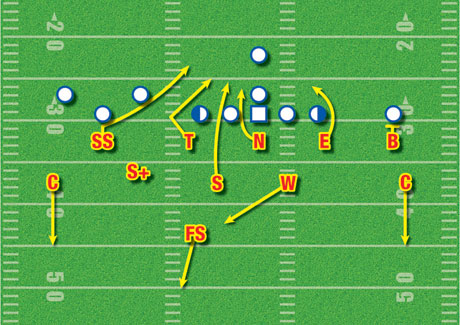AMERICAN FOOTBALL MONTHLY THE #1 RESOURCE FOR FOOTBALL COACHES
Article CategoriesAFM Magazine
|
The Situation© More from this issueYou’re on defense and facing a spread shotgun passing attack with trips to your right side on the wide side of the field. A lone receiver is also flanked to your left. You are up seven, 35-28, late in the fourth quarter. Now you face the most critical play of the game: fourth and eight on your 18-yard line. What defense do you use and how do you play the four wide receivers so you can get the ball back? Don Smolyn, Head Coach, Lenape Valley High School, Stanhope, NJ. AFM subscriber since 1995. We have a six-man rush with a straight, tight-man coverage package that we employ at this point of the game. Our thinking is be that we want the ball thrown as quickly as possible with very little time for the quarterback to make any adjustments or to be able to scramble. We substitute our six fastest rushers into the game with the two fastest being the edge rushers. We will either have 2 ‘A’ gap, 2 ‘B’ gap, or 2 wide ‘C’ gap rushers. Or, because of the shotgun formation stack over the center, have 2 ‘B’ gap rushers and 2 wide ‘C’ gap rushers. The stack over the center will stunt with the back man going to the quarterback’s throwing-hand side. One point of emphasis to the six rushers is if they are blocked they should attempt to get into the quarterback’s vision and try to block the pass. This is possible because we think that it will be a short pass and know the distance required. If the quarterback is right-handed, use your left hand to attempt to disrupt the quarterback and right hand if the QB is left handed. In this situation 1-5 are our cover people with six rushers (‘R’). The fastest rushers are labeled #1 and #2. The cover people should have inside alignment and switch on all crossing patterns. Remember, the ball will come out quickly.
John McClean, Defensive Coordinator, Conroe High School (TX). AFM subscriber since 2002. In this situation we would call Claw Fire 48 Red Hammer. We run a 3-4 defense so we would have three defensive linemen. There would be a 5 technique strong that becomes responsible for the strong ‘C’ gap; a head up nose that would be responsible for the strong ‘A’ gap; and a head up 4 technique on the weak side that would be responsible for the weak ‘C’ gap. As for the inside linebackers, the Sam is lined up in a 30 strong side and blitzes in the strong ‘B’ gap. The Will is lined up in a 10 weak side and drops in the middle of the field after making a pass read. The bandit (weakside OLB) lines head-up with the single receiver and jams him at the snap of the ball. The corner to that side plays over the top of the receiver and is in man coverage on that receiver. The stud (strongside OLB) splits the difference between the offensive tackle and the #3 receiver. He will be responsible for the strongside flat if it is a pass. The strong safety lines head-up with the #2 receiver and blitzes off the edge. The left corner and the free safety play Cover 4 to the #3 receiver side. When breaking down the terminology, here is what each word means in the play call: ‘Claw’ is the front call; 'Fire' is for the Sam blitz; ‘48’ is the secondary coverage; ‘Red’ tells the strong safety to blitz; and ‘Hammer’ tells the weakside outside linebacker to jam the receiver to his side.
|
|
| HOME |
MAGAZINE |
SUBSCRIBE | ONLINE COLUMNISTS | COACHING VIDEOS |
Copyright 2024, AmericanFootballMonthly.com
All Rights Reserved






